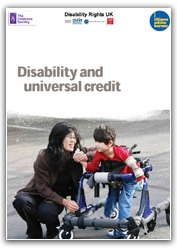Disability and universal credit

Disability and universal credit [ 1.7 mb] - available for download only
Background to universal credit
The plans for universal credit (UC) were laid out in the Department for Work and Pensions' Welfare That Works White Paper, published in November 2010, and the legislation to enable its introduction was created in the Welfare Reform Act 2012.
The new system has two key aims. Firstly, to improve work incentives for families who can currently find it extremely difficult to make work pay and secondly, to radically simplify the complex welfare system, by combining a number of key means tested benefits (including income support, income based jobseeker's allowance and employment and support allowance, housing benefit and tax credits) into one single entitlement.
The Government estimates that about 2.8 million households will gain financially from the changes, and about two million households will lose out. Whilst some disabled people will gain from the new system, many disabled people will get very significantly less help because some of the additional support in the current system will not be provided to the same degree in universal credit. We are very concerned that the scale of the cuts in support for some groups of disabled people has not yet been properly understood, because the changes have been viewed in isolation.
This briefing looks at four particular financial changes for disabled children, adults and their families, and considers how they will interact with the broader universal credit changes. Whilst three of the changes are cuts and one is an increase, not all the people affected by the specific losses and gains will lose or gain overall in the way that might be expected. This briefing will unpick some of that complexity.
See also
- Universal credit is coming - Find out about the changes and their potential financial impact on disabled children and adults

